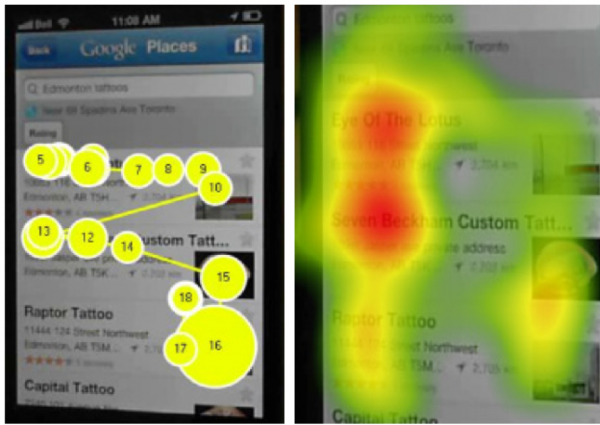Study: Reviews & Images Drive Clicks In Mobile
Last November Canadian digital agency Mediative (owned by Canada’s Yellow Pages Group) released an eye- and click-tracking study focused on Google Places and Google Maps on the PC. We wrote up the results when they were published. Mediative then followed up that study with a similar one focused on the Google Places app on the […]

For the iPhone-app study, just published yesterday, Mediative monitored eye- and click-tracking with 12 people in Canada. They ranged in age from 21 to 45. The participants were asked to find places to get a tattoo in each of several Canadian cities. Here’s the task as described by Mediative:
Every participant in the study was given the same scenario as in the previous Google Places study – an imaginary road trip with stops in Hamilton, London, Winnipeg and Edmonton, with the task of choosing a place for a friend to get a tattoo in each of those cities based on the Google Places search results. From the participants in the eye tracking part of our study, we recorded each individual session, and then compiled the sessions to create heat maps that represent aggregate gaze data and supplement the qualitative findings.
Screen size was a critical difference between the PC and iPhone studies. Beyond this Mediative found that images and reviews were very important in capturing users’ eye movements and clicks.
The image on the left shows yellow bubbles of various sizes. The larger the size of the bubble, the more time the eye spent in that area of the screen. The numbers represent the progression of movement of the eye across the screen during the first several seconds. In other words the eye spent the most time on an image on the right, which was nearly the last thing considered in this sequence.
On the right screen above, red indicates more time spent and green less time spent. The second image in this case got the most attention among the three images. Mediative explains: “It’s the only image on this screen of a tattoo; both the other images are of storefronts.” Thus the image was directly relevant to the searcher’s objective: find a tattoo vendor.
As a general matter, people on the iPhone app scanned left to right and then down the page, not unlike eye-tracking patterns on the desktop. According to Mediative, reviews were an especially significant factor in eye-tracking patterns in the iPhone test:
People typically start looking in the upper left part of the screen, scan from left to right, then move down to the next result, and scan from left to right again. However, given the small space of the iPhone screen, some people will have their attention pulled to the right to look at an image, and may continue a scan down to the next image, before resuming a left-to-right scan pattern. If they start scrolling down, then their gaze will stay on the left side until they hit a listing of interest. In the examples we used in this study, in almost every case it meant that they would scroll down until they hit a listing with a better than 3-star review.
What Mediative observed is that where there were fewer “social signals” (e.g., reviews) among the top results users went further down the page to find places that had not only reviews but at least three stars. According to the report, “This presents an opportunity for businesses whose websites are not listed at the top; they can be more competitive by adding positive reviews.”
Mediative offered the following conclusions and recommendations:
- Reviews and other social signals grab attention: “If a business website is listed in any position other than the top three, and the listing does not include any social signals, it will be relatively ignored, especially if there are other listings that do have social signals.”
- Reviews drive clicks: “Positive reviews on the Google Places iPhone app were the biggest single factor we observed that determine which listings got clicks and which did not.”
- Volume of reviews matter: Mediative found “that 29 of the 47 clicks went to listings that had at least four reviews.”
- Images matter too: “People . . . look at the images to see if the business looks trustworthy.” The type of image may matter as well: “We recommend giving the image that accompanies a listing some special consideration, and remember that an image that might work on a desktop might not work so well when reduced to a phone.”
You can download the entire report here (registration required).
Related Entries
- Eye-Tracking In Google Maps: Study Shows Value Of No. 1 Ranking & Social Content
- Eyetracking & SEO: Fad, Fact, Or Fiction?
- Eye-Tracking Study: Everybody Looks At Organic Listings, But Most Ignore Paid Ads On Right
- Survey: 6-10 Local Business Reviews Required For Trust
- Survey: Local Reviews Gaining In Importance
- Eye Tracking Study Shows Importance Of Search Snippets
Contributing authors are invited to create content for Search Engine Land and are chosen for their expertise and contribution to the search community. Our contributors work under the oversight of the editorial staff and contributions are checked for quality and relevance to our readers. The opinions they express are their own.
Related stories
